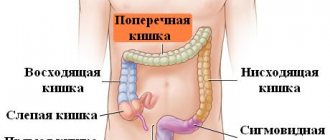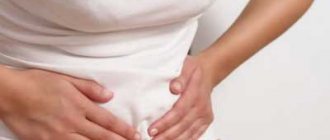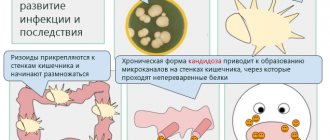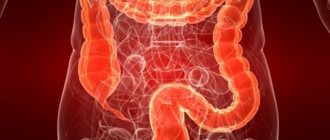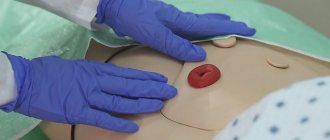The essence of the disease
Dolichosigma is the abnormal structure of the sigmoid part. This is the last section of the intestine that ends in the large intestine. An anomaly is defined as an elongation or increase in the diameter of the intestinal lumen. In a normal adult, the length of this section is approximately 24 to 46 cm. With dolichosigma, there are 2 or 3 additional loops. They can twist, fold in layers, and bend. By doing this, they interfere with the full passage of feces and intestinal gases.
According to medical statistics, every fourth person has such deviations in the structure of the intestines. Although the indicators should be higher, the difficulty of detecting the disease does not make it possible to accurately determine the disease in all cases. In children, the disease is registered in 40% of cases with problems with constipation.
Form and causes of occurrence
Congenital
- hereditary predisposition;
- taking synthetic drugs by a pregnant woman;
- illness during pregnancy with infectious pathologies;
- negative impact on the fetus of the environment, radiation;
Acquired
- chronic diseases of the digestive system;
- low physical activity;
- sedentary work;
- increased nervousness, constant depression;
- long-term treatment with potent drugs;
- poor nutrition, when the emphasis is on foods rich in carbohydrates. Eating a large amount of meat products;
- presence of bad habits.
The development of this disease is not associated with infection or inflammation. The impetus for the beginning may be the process of prolonged fermentation or rotting in the intestines.
Companions of the disease
The disorder, which usually begins in childhood, gradually leads to changes in the functioning of other organs. Failures in the digestive system and other problems begin. When the movement of feces is delayed and intestinal gases accumulate, dysbacteriosis and other abnormalities in digestion begin. Common accompaniments of the disease are gastritis, gastroduodenitis, and other digestive problems.
Constant pain, frequent bloating, increased gas production keeps a person tense and reduces the overall tone of the body. All this quickly leads to the development of stress. This condition is a predisposing factor in the development of gastritis.
Immunodeficiency occurs due to the inability of the intestines to function normally. Gradually, all sorts of infections begin to appear, and the body cannot cope with them. Symptoms of intestinal problems are manifested by specific rashes on the skin.
In children, pancreatitis, colitis, biliary dyskinesia, and disturbances in the functioning of other parts of the digestive system are additionally detected. In adults, varicose veins and hemorrhoids are associated with the disease.
Causes
The etiology of the disease has not been reliably established. It is assumed that the abnormal development of sigma occurs in the prenatal period (infections in the mother or taking certain medications, genetic failure), and a number of unfavorable factors in the life of a child or an adult provoke the development of the disease. Taking into account the fact that sigma lengthening may be a variant of the norm, the following factors may be the causes of pathological changes.
- Putrefactive and fermentation processes resulting from malfunctions of the digestive system.
- Age over 40 years and the accompanying sedentary lifestyle.
- Stressful situations.
- Abuse of meat and carbohydrates.
Manifestation of pathology
Symptoms of abnormal intestinal structure may be mild. A sick person may not even notice them. In some cases, the disease is accidentally discovered during diagnostic testing for another reason.
One of the signs of lengthening of the intestinal tract will be abdominal pain. The patient cannot indicate the location of the painful sensation - it hurts everywhere, throughout the abdomen. The more defecation has passed, the stronger the feeling of pain. Dolichosigma of the intestine in adults is accompanied by pain around the navel and in the left iliac region.
Main symptoms:
- prolonged constipation (in some cases up to a month);
- bloating;
- poor appetite;
- increased gas formation;
- rumbling;
- dry feces;
- feeling of fullness in the intestines;
- attacks of nausea, possible vomiting;
- pale skin;
- fatigue, depression, sleepiness;
- putrid odor from the mouth;
- white coating on the tongue;
- hair loss;
- fragility of nail plates;
- feces acquire an unpleasant odor and sometimes contain traces of blood.
Black color of stool indicates bleeding in the intestines. In this case, you should urgently seek medical help.
Symptoms of pathology
This pathological feature is caused by disturbances in the functioning of the large intestine of the stomach, as well as subsequent toxic poisoning, which is facilitated by the accumulation of feces in the body.
The main symptoms of the formation of loops in the intestines
In patients suffering from manifestations of negative symptoms of the disease, manifestations occur in the form of:
- Frequent, severe constipation;
- Decreased reflexes to defecation;
- Changes in the consistency of stool;
- Toxic damage to the body;
- Presence of blood in stool;
- Bloating;
- Pain in the peritoneum and groin area;
- Decreased appetite;
- Heaviness in the stomach.
At the initial stages of pathological processes, the appearance of constipation is extremely rare, usually expressed in the absence of bowel movements for no more than three days, but as the disease progresses, the frequency of delays increases.
In especially severe cases, the duration of absence of bowel movements can reach one month.
Stagnation of feces leads to an increase in the diameter of the sigmoid colon, but at the same time the thickness of the intestinal walls decreases, which threatens cracks in the walls of the stomach and bleeding.
Fecal masses become denser and become larger in volume, which during defecation can lead to cracks in the anal canal. At the same time, the smell of feces intensifies and becomes more offensive.
Severe pain in pathology is rare, but recurrent attacks occur, which appear several times over the course of a month.
Disruption of the intestines can cause increased gas formation in the intestines (flatulence), which leads to sharp short-term pain in the abdominal area.
Symptoms worsen after eating or exercising.
Pain also occurs due to intestinal spasms. With the pathology of the formation of intestinal loops, inflammatory processes can begin, which leads to disruption of mucus production and other serious consequences in the form of colitis and peptic ulcers.
Diagnostic measures
During the initial examination of the child, the doctor notes pale skin, general lethargy, low weight, developmental delay. Palpation of the abdomen reveals distended intestinal loops filled with feces. The rectal method shows an empty rectum - the body is not ready for emptying even with excess feces.
Irrigography has proven to be a good method. This is a method of radiographic examination using contrast, which allows you to view all parts of the intestine of interest. Computed tomography helps to examine additional loops in detail. The device will show the thickness, lumen diameter, location, shape, and many other necessary parameters.
An ultrasound examination will allow you to examine the formed loops and possible enlarged areas. During a colonoscopy, the inner surface layer is examined using a flexible probe. If necessary, material will be collected for further examination. They examine blood and feces, identifying infection and inflammation.
When diagnosing intestinal dolichosigma in a child, it is necessary to exclude chronic appendicitis, entenitis, and agangliasis. These pathologies have similar symptoms.
Relationship between symptoms and stage
Treatment of dolichosigma in adults begins with the doctor determining the degree of development of the disease. At each stage, the disease manifests itself differently:
- Compressed.
At this stage, most patients are not even aware of their illness, since there are no complaints about their health. But when palpating, the specialist feels that the intestine is filled with solid contents. This stage is the easiest to treat; you just need to choose the right diet for the patient and take mild laxatives. In this case, the gastrointestinal tract will begin to function normally.
- Subcompensated.
At this stage, constipation becomes longer lasting, so the use of laxatives does not have the desired effect unless additional cleansing enemas are used. Here the first signs of intoxication may be observed.
- Decompensated.
This degree occurs quite quickly, and the patient’s condition quickly deteriorates. The desire to eat disappears, while the patient suffers from a feeling of nausea and even vomiting. Constant headache, lethargy and weakness are observed, which may be signs of developing anemia. To cleanse the intestines, you have to use only siphon enemas.
Against the background of all the symptoms, the doctor prescribes a diagnosis, which includes several measures:
- Inspection.
Even visually, a patient with dolichosigma is distinguished by low weight and pale skin. Also at the initial visit, the specialist performs palpation of the abdomen and a rectal examination. At the last examination it will be seen that, despite complaints of constipation, the rectum remains empty.
- The patient must undergo irrigography, which allows one to detect the number and degree of intestinal curls.
- Computed tomography provides very accurate results, allowing you to examine the mucous membrane of the large intestine. Using CT colonography, the doctor sees the presence or absence of space-occupying formations.
- With dolichosigma, it is important to determine the state of intestinal motility. For such purposes, electromyography and sphincterometry are performed.
And of course, feces must be submitted for testing. This allows you to identify the presence of bloody inclusions, dysbacteriosis and worms. At the same time, blood is also donated.
Based on the results of all the tests performed, the doctor draws up an overall picture and can already select a course of treatment for the disease.
Treatment methods
The abnormal structure of the intestine begins to be treated with therapeutic methods, and in special cases they resort to surgical intervention. Drug treatment in adults includes laxatives to empty the intestines, vitamins to support the body, and special agents to reduce the formation of intestinal gases. For severe pain, painkillers are prescribed.
Usually the patient is prescribed enemas, but with their frequent use, the intestines cease to empty themselves naturally. You need to be careful when using enemas. Do not exceed the amount recommended by your doctor.
Electrical stimulation of the colon successfully restores motility. We also recommend feasible physical activity and a special massage of the anterior abdominal wall. An effective method is the procedure of colon hydrotherapy - this is a cleansing that is carried out using a specialized apparatus. The intestines are washed with water with the addition of mineral solutions, medicinal herbs or microflora.
Classification of dolichosigma
Depending on the size of the sigmoid colon and its position in the abdominal cavity, there are S-shaped, single-loop, double-loop and multi-loop. As a rule, dolichosigma is considered to be an elongated two-loop or multi-loop sigmoid colon, which has pathological mobility, moves freely and retains its additional loops after complete bowel movement.
There are three forms of the disease, which can also be considered as successive stages:
- The compensation stage is clinically manifested by abdominal pain and periodic constipation lasting up to three days. Achieving bowel movement occurs through following a special diet, as well as taking mild laxatives. At the same time, general health remains normal.
- The subcompensation stage is characterized by constant constipation, abdominal pain and flatulence. The use of laxatives to regulate stool is ineffective, which in turn forces one to resort to frequent cleansing enemas.
- The decompensation stage is the most severe form of dolichosigma. In this case, constipation lasts more than seven days, and abdominal pain constantly bothers you. The large intestine is swollen and enlarged due to the large accumulation of feces and gases. At this stage, symptoms of intoxication are expressed: loss of appetite, nausea, pustular rashes are noted on the skin. Signs of intestinal obstruction may also occur. For the purpose of complete bowel emptying, only siphon enemas are effective.
Diet features
An important addition to conservative treatment is dietary nutrition. It should be satisfying to compensate for the lack of nutrients. Products should stimulate motor skills whenever possible.
Rules for eating with dolichosigma:
- Frequent meals – at least 6 times a day.
- Chew food thoroughly; swallowing large pieces is not allowed.
- Drinking enough clean drinking water.
- Avoid overeating, especially in the afternoon.
- Mandatory consumption of fermented milk products - yogurt, kefir.
- Include vegetables and herbs in the menu. They contain magnesium, which has a beneficial effect on intestinal motility.
- Add vegetable oil to food.
- Vegetable juices are useful - carrots, potatoes, cabbage.
Foods rich in fiber can be harmful when treating an adult. In a diseased intestine, inflammatory processes may already begin, in which such food will cause an exacerbation. This issue is resolved during diagnosis. Treatment should only be prescribed by a doctor; self-medication is dangerous.
Treatment
Therapy for dolichosigma must be comprehensive. It includes the following activities:
- diet;
- drug treatment, including laxatives;
- physiotherapy.
Operations for dolichosigma are rarely performed. They are indicated in cases of prolonged constipation, even against the background of conservative therapy, with the formation of fecal stones, severe pain, intestinal perforation or obstruction.
Diet therapy
The diet is aimed at preventing constipation and stimulating bowel function.
Foods high in fiber (vegetables, fruits, nuts, bran) and vegetable oils, such as olive, are beneficial. They contribute to the formation and movement of feces and stimulate peristalsis. At the same time, you need to limit foods that slow down the intestines: starch-rich vegetables (potatoes, bananas), flour products, rice and semolina. The list of “useful” and “harmful” foods for dolichosigma is given in the table.
To prevent constipation, it is useful to include wheat bran in your diet. They are pre-soaked for 15-20 minutes. Then add to salads, vegetable dishes, cutlets. Adults can take 1 teaspoon 3-4 times a day. The amount of bran is gradually increased and brought to 6 teaspoons per day. At the same time, it is necessary to take a sufficient amount of fluid, at least 2 liters per day.
Medicines
They are prescribed mainly to normalize intestinal function and reduce the severity of symptoms. Since constipation is the main problem, laxatives are recommended:
- Dufalak;
- Sodium picosulfate (Guttalax);
- Bisacodyl;
- Vaseline oil.
Herbal choleretic agents, for example, artichoke leaf extract, also have a laxative effect. If there is no effect, do enemas with water at room temperature or microenemas (Microlax).
The treatment regimen also includes the following groups of drugs:
- Prokinetics (Itomed);
- Antispasmodics (No-shpa, Mebeverine);
- Gastroprotectors (Rebagit);
- Probiotics (Bifiform).
Treatment usually lasts from 10 to 15 days. Laxatives are prescribed either periodically or in courses (for example, Dufalac for 15 days).
Physiotherapy
Any type of physical activity is beneficial, in particular exercises that strengthen the abdominal muscles. Abdominal massage stimulates peristalsis: perform circular movements along the intestines, in a clockwise direction. The massage is done half an hour after breakfast and an hour and a half after lunch, lasting 10 minutes.
When lengthening the sigmoid colon, electrical procedures with proserin and acupuncture are indicated. Sanatorium-resort treatment in cities such as Essentuki, Truskavets, Zheleznovodsk is useful.
Surgery
Surgery is a radical method of treating dolichosigma. It is necessary in case of complications, volvulus or obstruction. Technically, the operation involves removing (resection) part of the large intestine. Usually one-stage surgical interventions are performed, less often two-stage. As a result, intestinal function is restored in operated patients. Episodes of stool retention occur after errors in the diet and are short-term in nature.
Carrying out the operation
In some cases, surgical intervention is indicated. It is usually performed in adult patients.
Reasons for the operation:
- additional loops cannot be straightened;
- ruptures of the intestinal walls appeared;
- poisoning of the body increases due to rotting of feces;
- Conservative treatment methods did not bring positive results.
During the operation, additional loops are removed, blood supply and normal motility of other parts are restored. Surgery is performed under general anesthesia. Medical technology and modern devices make it possible to avoid complications.
If all the recommendations of the attending physician are followed, the person leaves the hospital healthy, with a stable intestine. For 4 months you must adhere to a diet and do not lift weights.
Possible complications
If treatment or surgery is delayed, this disease leads to dangerous consequences. One of the serious complications is perforation, that is, a through hole in the intestinal wall. Everything that is in the intestine at this moment will penetrate into the peritoneum. This leads to infection if timely assistance is not provided.
This is followed by peritonitis, which is very difficult to fight. Pus affects internal organs, some have to be removed to save a person’s life. Subsequently, this introduces certain difficulties into the functioning of the body.
A big problem is fecal stones - compressed feces. They have a sharp unpleasant odor, torment the patient with pain, lead to acute obstruction, being a consequence of untimely treatment of this disease.
Another complication is purulent lesions on the skin. They appear as a result of the action of toxic substances from rotting intestinal stool. Skin ulcers are a breeding ground for any other pathogenic microorganisms that colonize there. A persistent cosmetic defect with an unpleasant aroma appears on the skin.
Therapeutic gymnastics: 8 exercises for good bowel function
When a patient is diagnosed with dolichosigma, massage and exercises become a mandatory component of complex treatment. To perform them, you do not need to look for specialists; exercises and massage can be performed at home yourself, having mastered several simple techniques. The article will help you understand what you need to pay attention to and what means of treatment should be used. With this pathology, the patient develops chronic constipation, which is what causes the first ailment in the early stages and triggers irreversible consequences in the latter.
Therefore, both massage and exercises for dolichosigma are aimed at eliminating this concomitant complication. A properly performed massage stimulates peristalsis and helps move feces through the intestines. But you can’t massage your stomach too much. Hard palpation of the internal organs located in the peritoneum can provoke pain, nausea and even vomiting, so you must act with extreme caution.
Massage for dolichosigma is performed using the following techniques:. When the patient leads a sedentary lifestyle, the manifestations of dolichosigma intensify, but not everyone knows whether it is possible to play sports if the described diagnosis has been made. High physical activity is contraindicated for dolichosigma, but regular gymnastics, as well as special exercises for dolichosigma, are very useful.
Patients can play sports, swim, ride a bike, take long walks, but performing special physical exercises is also very useful. They help improve intestinal function and have a beneficial effect on the general condition of the patient as a whole.
So, patients can be advised to start the morning with light gymnastics, which includes the following exercises; there is no need to get out of bed: During the day, a patient with dolichosigma is allowed moderate physical activity; you can play sports, but not professionally.
It is useful to constantly squat throughout the day; this physical exercise for dolichosigma stimulates the urge to defecate. The methods described above help massage the intestines and effectively combat the most important symptom of dolichosigma - prolonged constipation.
Using exercise therapy and playing sports is also useful for preventive purposes. It has been noticed that daily fifteen-minute training paired with a massage for dolichosigma leads to very good results: muscles are gradually tightened, digestion is normalized, problems with the table are resolved much faster.
Our colon is a vital part of our digestive system, and without it we will not be able to naturally process food and remove waste and toxins from our body. In some children, one of the sections of the large intestine is enlarged in length, which causes difficulties with the process of emptying it. Next, we will look at the symptoms of this pathology, called dolichosigma, and describe some treatment methods. Constipation is a common problem in childhood; it is usually associated with the child’s diet and goes away after some time.
But if difficulty in defecation occurs regularly, you should take this problem more seriously. This manifestation is a symptom of a number of diseases. Dolichosigma is one such pathology. Dolichosigma is a structural abnormality of the sigmoid colon. With this pathology, the sigmoid colon lengthens, but its lumen does not change in diameter, and the walls do not become thicker. The exact reasons for this anomaly have not yet been identified. Sometimes congenital pathology is the result of exposure to radiation, toxins, and various chemical and physical factors during fetal development.
Dolichosigma can also develop if a woman has an infectious disease during pregnancy. The correct development of the fetus can be disrupted by the use of certain medications by a pregnant woman. Congenital or acquired increase in the length of the sigmoid colon underlies the pathogenesis. If there are concomitant pathologies, fibrosis of the intestinal tissue often occurs; as a result, connective tissue replaces normal intestinal tissue.
Hyperemia and swelling appear. Muscle fibers grow, as a result of which the intestinal walls are abundantly saturated with tissue fluid. All this disrupts intestinal contraction and weakens its tone. A decrease in contraction processes makes it difficult for feces to pass through the intestines, resulting in constipation. Due to the constant presence of feces in the intestine, the innervation of cells is disrupted, stagnation, pain and intoxication develop.
Symptoms occur as the intestines fill with feces and the body becomes intoxicated. The intensity of the disease is directly proportional to the degree of morphological and functional disorders in the intestine. In comparison with other gastrointestinal pathologies, dolichosigma is represented by bright characteristic symptoms.
Here are a few of them:. A child with dolichosigma becomes lethargic, capricious, cries all the time and refuses to eat. The main symptom is constipation with gradually increasing frequency. This is usually due to the transition to mixed feeding or the introduction of complementary foods, which entails a change in the consistency of stool and an increase in its quantity.
Most affected children have functional disorders of other parts of the gastrointestinal tract: diverticular disease, colitis, dysbacteriosis, pancreatitis, biliary dyskinesia, chronic gastroduodenitis, etc.
The sigmoid colon often increases in length even in childhood, and the stable progression of the disease over time leads to severe complications. This is a prolapse of the transverse colon. Occurs most often as a result of a defect that developed in utero. It is characterized by stagnation of fecal matter, persistent constipation, and nausea and vomiting.
The pressure can damage the bladder. More often the right side becomes inflamed, but adjacent organs are involved in the inflammatory process. Without treatment, intestinal obstruction develops. This is an inflammation of the intestinal mucosa. With dolichosigma, colitis occurs against the background of many days of absence of stool, since fecal matter does not pass out and accumulates in the intestine.
All this leads to the production of toxins, the development of intoxication, and irritation of the intestinal walls. The mucous membrane swells, hyperemia occurs, excessive blood flow into the vessels of the organ, irritation. The feces become dark in color and have a foul odor. With this pathology, the large intestine lengthens along its entire course.
The walls of the organ expand and thicken. Manifestations include chronic stagnation of feces, intoxication of the body, irritation of the walls of the organ. As a result, inflammation develops. Over time, fibrosis occurs, thinning of the mucosa and its replacement with connective tissue. The depth of damage increases, the muscle layer, submucous membrane and nervous tissue are affected.
The specialist then examines the patient. The abdomen, intestines and area of the sigmoid colon are carefully palpated. Percussion tapping is carried out on the areas where the compaction is found. Using the method of auscultation, sounds observed in the intestine are heard, this will allow one to determine the approximate direction of the dynamic processes occurring in the intestine. The information obtained will allow you to make an approximate diagnosis. To confirm it, additional instrumental and laboratory studies should be carried out.
A number of tests must be performed to make a diagnosis. In general blood and urine tests, you can see signs demonstrating the stage and nature of the pathology: the presence of inflammation, infection, intoxication. Biochemical analysis will show the characteristics of metabolism and the main processes occurring in the body.
A stool occult blood test will reveal internal diseases. The presence of blood hidden in feces may indicate the presence of cancer at an early stage. The coprogram provides information about the quality of food digestion. Examination of feces for helminth eggs is also mandatory. Analysis for dysbacteriosis is carried out if necessary. Only irrigography can detect an increase in the length of the sigma.
Before starting the procedure, a barium enema is administered. Ultrasound can be used to examine intestines clogged with dense feces. It is impossible to perform a CT scan on young children because they cannot remain motionless for a long time. Using a thin pediatric probe, a colonoscopy is performed under short-term anesthesia, if necessary for differential diagnosis. This procedure makes it possible to examine the colon and assess the degree of damage to the mucosa.
Treatment of dolichosigma is a very complex process and includes two main directions: therapeutic conservative treatment and surgery. First, conservative methods are used - medications, massage, diet, physical therapy, etc. Surgical intervention is performed exclusively as a last resort.
Traditional medicine methods are often added to traditional means of therapy, but they complement and do not cancel the above methods of treatment. To achieve effectiveness from treatment, the digestion process should be carried out. There are certain rules for choosing products and their consumption:.
When the diet does not produce results, it is necessary to give the child pharmaceutical drugs. Before taking them, you should first consult with a specialist, as complications may arise, and an overdose will lead to the development of side effects: intestinal irritation and increased intestinal motility.
These drugs give results at the initial stage of pathology development. They are effective at the early stage of dolichosigma development. The appointment is carried out in strict accordance with medical indications and the age of the child. The glycerin-based drug is available in the form of suppositories for rectal administration. It has a beneficial effect on intestinal motility and softens fecal matter.
Can be used from birth.
Results
Dolichosigma is an unpleasant disease. It is necessary to treat as soon as the first symptoms appear. Traditional methods of therapy show good results. Traditional medicine serves to improve the health of the body; its recipes must be used with the approval of the attending physician.
The prognosis for recovery is favorable. Surgery is not considered a last resort measure. After it, the intestines are restored and begin to work well. After 4 months, the person is allowed to eat all food and do normal activities, that is, recovery occurs.


